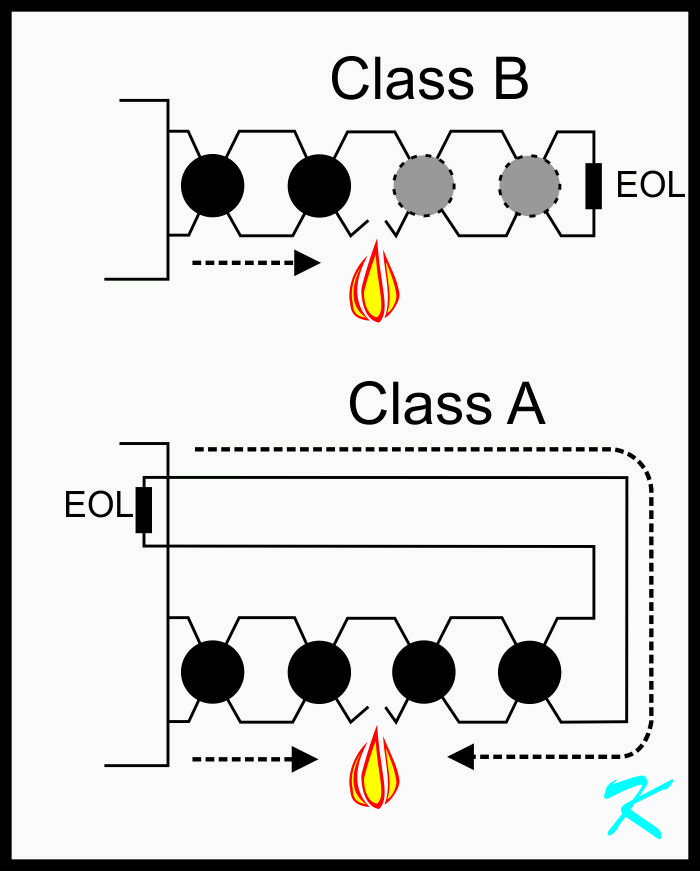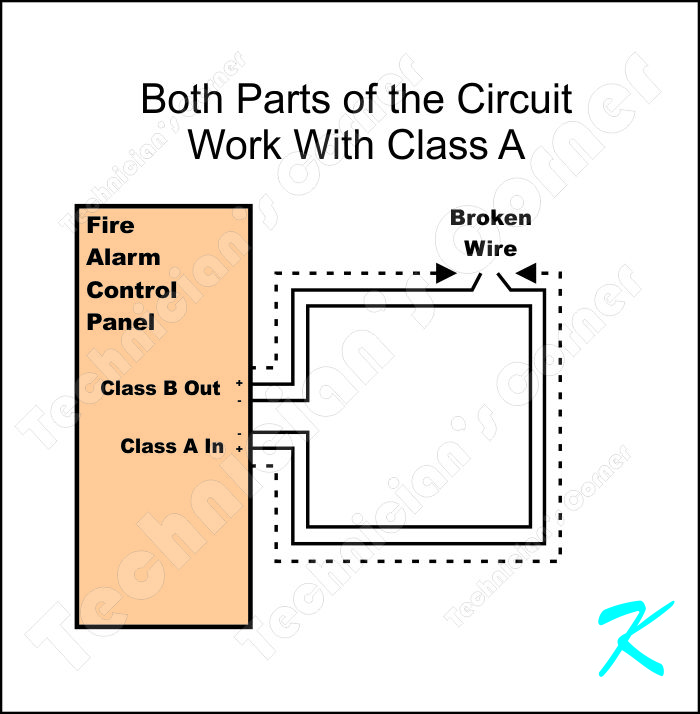Whether or not conventional devices can be used with a Class A building circuit depends on what panel is used.
Class A is a description of the circuit in the building. The panel and the devices have to match.

With a Class B circuit, all devices beyond a break are disconnected from the panel. With a Class A circuit, all devices, even beyond the break, are still connected to the panel.
With a conventional building circuit, the difference between a Class B building circuit and a Class A building circuit is the location of the end of line resistor. If the resistor is somewhere else than the fire alarm panel, it's a Class B building circuit; if the resistor is in the circuitry of the fire alarm panel, it's a Class A building circuit.
Usually, with a conventional building circuit, a device is a device.
Code Requirements
This is a summary of the National Fire Protection Association's (NFPA) description of a Class A building circuit:
- This will include a redundant signal path - If the path is interrupted, the system feeds both ends of the paths so there are now two paths; the original outgoing path which is now cut shorter, and the return path which is now being used as an outgoing path
- If wires are used, a wire-to-wire short may shut down the whole path
- Both conventional and addressable systems fit into this
- Both the IDC (Initiating Device Circuit) and the NAC (Notification Appliance Circuit) fit into this
- The panel shows a trouble signal when there is a problem
Also, the feed and return route of the wire throughout the building cannot be together; the feed (Class A Out) and the return (Class A In) sections of the Class A building circuit cannot be in the same conduit or in the same bundle of wires.

Whether it's a conventional Initiating Device Circuit (IDC), a conventional Notification Appliance Circuit (NAC), or an addressable Signaling Line Circuit (SLC), this is how a Class A circuit works.
This shows two different routes for the wire. In a Class A building circuit, if the whole pathway for the wires in broken, any devices beyond the break will still work.
Technical Requirements
The NFPA also states in their code that everything used in a fire alarm system has to be "Listed for Use". Listed for use is legal-ease for "Tested by a Third Party, National Known Testing Laboratory, and has been Found to Work, and then Placed on Their List of Systems or Devices that Actually Work as Advertised".
With most manufacturers, some fire alarm system models will work with either Class B or Class A building circuits, some fire alarm systems will only work with Class B building circuits.
Because the overall fire alarm system has to actually work, the panel's "Installation Manual" or the device's "Installation Sheet" has to be consulted to find out if the panel or the device can be used with a Class A building circuit.
The Installation Manual and the Installation Sheets show the specific wiring method used by the testing laboratory for the test. Any other wiring method than what is shown may not be reliable, or may not work at all.
For design work, the Installation Manual and Installation Sheets are available from the technical support team for the manufacturer.
Make sure they're the "Installation" manual or sheets; advertising literature showing features of the equipment is often out of date, or doesn't fully show what is needed.
Douglas Krantz



